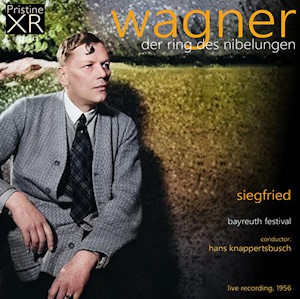
Richard Wagner (1813-1883)
Siegfried
Siegfried – Wolfgang Windgassen (tenor)
Mime – Paul Kuen (tenor)
Brünnhilde – Astrid Varnay (soprano)
Wanderer – Hans Hotter (bass-baritone)
Alberich – Gustav Neidlinger (bass-baritone)
Fafner – Arnold van Mill (bass)
Erda – Jean Madeira (contralto)
Woodbird – Ilse Hollweg (soprano)
Chorus and Orchestra of the Bayreuther Festspiele/Hans Knappertsbusch
rec. live 15 August, 1956, Bayreuth
Score and libretto available as download
Pristine Classical PACO212 [4 CDs: 251]
This third instalment of the 1956 Knappertsbusch Ring features Windgassen as Siegfried. He is very much a known quantity, having been Bayreuth’s regular Siegfried during the 1950s and also singing the role in Solti’s studio recording. There he was a last-minute substitute for Ernst Kozub, an impressive Siegmund who had, however, failed to learn the part of Siegfried adequately. Kozub arguably had more of a Heldentenor voice than Windgassen, but that is not much use if you don’t know the role, and that Wingassen certainly did. He also had the stamina to sing it and he does so heroically here, even managing to maintain his own with the Brūnnhilde of Astrid Varnay who arrives fresh in time for the final scene.
Mime is Paul Kuen, as it was in Rheingold. Solti kept Kuen in his studio Rheingold but dropped him for Gerhard Stolze in Siegfried (Stolze also recorded Mime in both Rheingold and Siegfried for Karajan.) Stolze had a remarkable voice and his interpretation of Mime verged on caricature, tending towards a kind of manic cackle. Kuen is an easier voice to listen to and he makes the most of the lyrical parts of his role, his wheedling and scheming.
With these two and Hotter in good voice as the Wanderer, the first act goes with a will. I always enjoy the riddle scene between Mime and the Wanderer, and the forging of the sword Nothung is particularly impressive; I believe Windgassen did his own (notated) hammering here – in the Solti recording they used a separate percussionist.
The second act begins with a highly evocative rendering of the dragon music from the orchestra. The scene between the Wanderer and Alberich, again the peerless Neidlinger, is powerful. The one between Siegfried and Mime which follows is at a lower level of tension and is followed by the Forest Murmurs passage in which Siegfried hears birdsong and tries to emulate it with a reed – actually a cor anglais in the orchestra. Sadly, I found this passage lacking in magic; it did not shimmer and sparkle as it should. After a splendid horn call from Siegfried, Fafner appears, here Arnold van Mill as it was in Rheingold, and using a megaphone as instructed by Wagner. His dying words are almost touching, as he seems to have no animosity for the hero who has killed him and even warns him against Mime. We then have the enchanting Woodbird of Ilse Hollweg advising Siegfried to take the tarnhelm and the ring from Fafner’s hoard. While he is doing so we have the comic scene between Alberich and Mime, quarrelling about the possession of the treasures which neither of them is going to get. Mime then wants to drug Siegfried, kill him and obtain the ring, but Siegfried understands his true intentions and kills him instead. The act ends with his being guided by the Woodbird to Brūnnhilde’s rock.
It was at this point that Wagner laid down his pen in 1857 and did not resume composition until 1869, with Tristan und Isolde and Meistersinger occupying much of his time in between. The opening of the third act, representing Wotan’s life as Wanderer, is one of the most powerful orchestral passages in the Ring and here sounds tremendous. Sadly, when he appears, Hotter sounds much more tired than in the two previous acts and his voice is unsteady, so the scene with Erda, the excellent Jean Madeira, is not as impressive as it should be. When the Wanderer confronts Siegfried, Siegfried gets the better of him, not only according to the story but also in this performance. The passage through the fire and Siegfried’s waking of Brūnnhilde go very well. I had not realized how much of this last scene is given over to the two principals wondering about themselves and each other and how little to the actual love duet at the very end. I enjoyed this scene more than I often do, and both Windgassen’s and Varnay’s intelligent understanding of their roles made all the difference.
With the possible exception of the Forest Murmurs passage in the second act, Knappertsbusch maintains a firm grip on the proceedings, always keeping the music moving; this is, after all, said to be the scherzo of the Ring. The orchestral balance is as in the third act of Die Walkūre, that is to say, better than in the earlier stretches. Solo woodwind lines can be heard, though sometimes faintly, and the brass do cut through when needed. Pristine Audio’s Ambient Stereo processing makes it all easy and pleasant to listen to. Those following this Ring will be happy to have this third instalment.
Stephen Barber
Previous review: Ralph Moore (April 2024)
Availability: Pristine Classical


















